Wild Lands by grassy gnoll
I Got to Say It, and It’s Hard for Me
Original SA post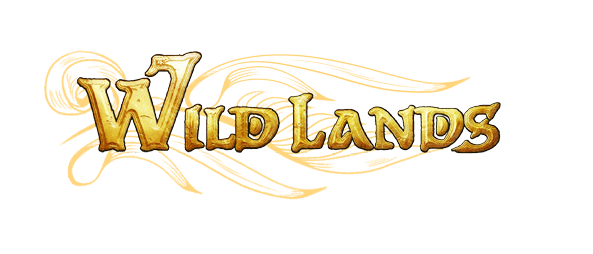
I Got to Say It, and It’s Hard for Me
https://stephenwoodgames.com/
https://www.drivethrurpg.com/product/286012/Wild-Lands
Wild Lands is a standalone system released in August of 2019 by Stephen Wood Games, and it will shock you to learn that the creator is a guy named Stephen Wood. I’m using creator specifically here because I needed a sufficiently encompassing word - Wood did the game design, setting, layout, and illustration for the whole book.
Wood himself is an illustrator by trade, with a master’s degree in the field and a good deal of lecturing on the subject under his belt. It shows, and Wild Lands is lavishly illustrated - I think I counted maybe a two page gap between illustrations in the whole book.
The illustrations are actually how I stumbled onto the game. I use Twitter as an art RSS feed, and some of the pre-press sketches were circulating around. I figured they were the typical idle “I’d love to make a game of this someday” scribblings. But no, there was an actual game with an upcoming release date attached to them. So, already we’re in the top 99% of illustrators for actually delivering on a product made in someone’s spare time. I can’t count the number of times I’ve fallen into that particular pit of slack-ass myself.
I feel like Wood and I come from pretty similar backgrounds. This is a labor of love by someone who grew up with the same nerdy stuff I did, playing the same games I did, from someone trained as an illustrator, it’s gorgeous to look at, it aims for a lot of the goals I like to see in an RPG, and it’s one of the heartbreaker-iest things I’ve ever laid eyes on.
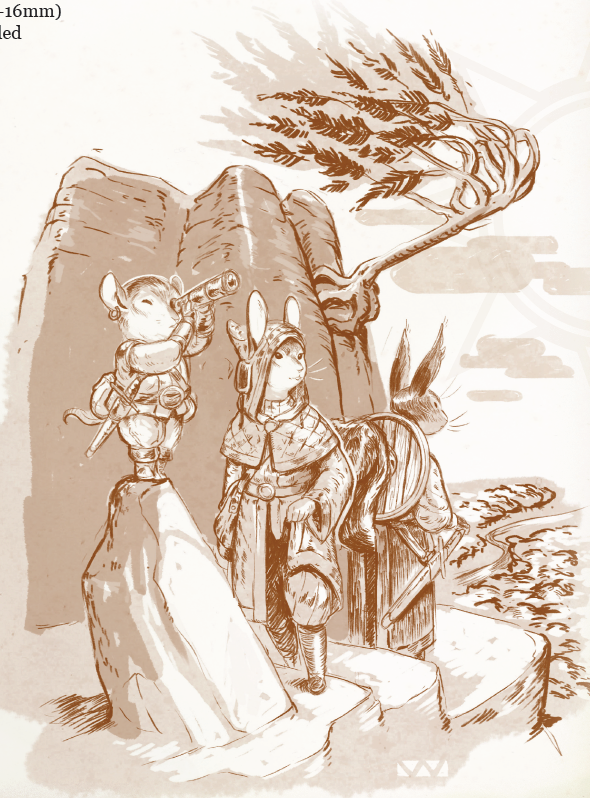
This is just dropped as a page filler. This’d be a full-page spread in another game.
Wild Lands is a rules-light RPG designed for quick pick up and play, where you take on the role of a Redwall-esque Critter and go out adventuring, in a vaguely fantastical setting. Wild Lands is also a fiddly dungeon crawler with randomly-generated loot and stats that make up your mechanical ability to interact with the world, an equipment list that echos Monster Hunter titles, and a bevy of Pathfinderian subsystems. Wild Lands is, in addition, a beautiful object of art that is poorly laid out as a teaching or a reference document.
This game, you guys. This game.
Wicked Little Critta
Original SA post
Wicked Little Critta
Wild Lands plunges straight into character creation. The first thing you’re asked to do is pick the species of your character, since this is a funny-animal game.
On one hand, as a very first-time thing, it’s kinda interesting to just present your players with an aesthetic choice and have them pick whatever appeals to them first. On the other, you’re asking your players to make a meaningful mechanical decision along with that choice, without knowing literally anything about the game system, and it’s devoid of impact if you play the game more than once. There’s also some implied knowledge throughout the game you’d only have if you had played tabletop games before, and in some systems that’s fine, but it says right on the cover this game is for ages twelve and up.
Some kind of briefing about the resolution system should be mandatory for any game under the sun. Don’t let your players make uneducated choices.
There’s a callout text in the intro to chargen that I treasure. It reads
quote:
No matter what the player’s artistic ability, it is highly recommended that they doodle a portrait of their character before playing if able.
And I love this. You can tell this came from a writer who teaches illustration. There’s a spot blocked out for it on the character sheet, too. A+, this is great and I want it in more games.
The term “critter” is used in place of “people,” which rubs me the wrong way for reasons I can’t really put my finger on. Your critter type can give you a stat bump, a special ability, or a bump to derived stats. Nothing gives you negatives, which is always a good sign. But! What mechanical benefits you get are wildly variable, and there’s not been any effort toward balance made here.
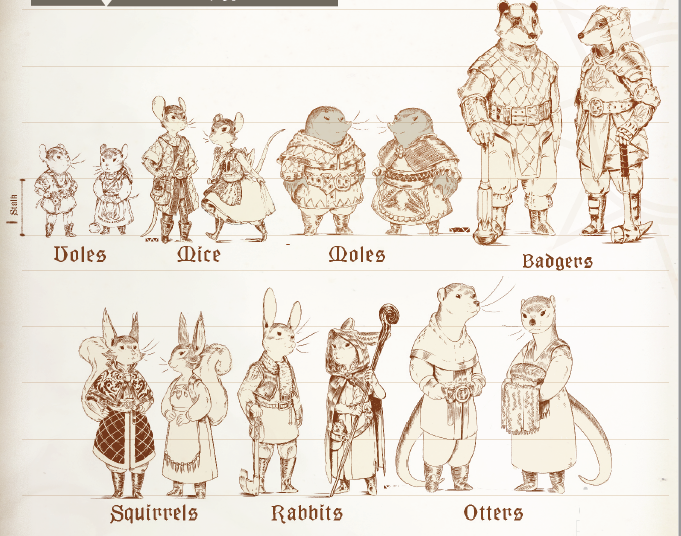
A lineup of some of the critters.
Note that in the above image, you can see the unit marker off to the left side there. It’s called a “stalk.”
I cannot stand cutesy special names for common things that should be otherwise instantly comprehensible to a lay person. Thankfully, Wild Lands never reaches Cranian levels of excess with this gimmick, but it’s a fucking subsitution cipher in the middle of what’s intended to be a reference document. Here, a stalk is a foot. Like, to the point where an early release of the game had “foot” typoed into place of “stalk” a few times. Currency does this too, and we’ll touch on that towards the end of this update.
Each critter gets a full-page spread with color illustrations. There’s a blurb on their general appearances and personalities, usually with a specific callout toward height. I get noting how big or small a thing is in a Redwallish game is, but it’s got a lot of numbers attached to it for something that I haven’t actually found associated with a mechanic. I’m hoping I’m missing something and I’ll trip over it in the course of this F&F.
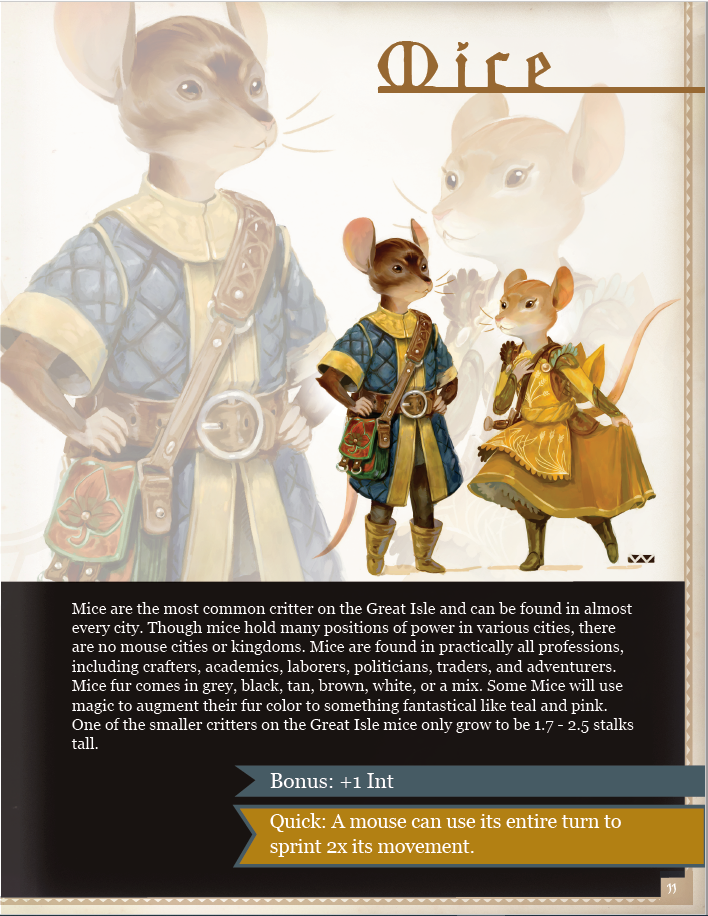
Meese.
Mice
One generic unit of adventurer. Humans from D&D. You can read the blurb above, but I want to call out a few things. One, apparently there’s enough magic around and it’s commonplace enough that mice use it to give themselves punk dye jobs. This isn’t touched on much in the setting chapter, and that seems like a misstep.
Two, can you tell me in a vacuum the value of +1 Int? Or whether being able to sprint at 2x speed is worth giving up your other actions that turn?
Let’s get into that.
Chargen goes pick critter, roll stats, pick skills, buy gear.
The stats are
Physicality - strength and con together, called out as favored for combat characters. Determines HP.
Agility - Speed and acrobatic ability. It’s dex, but also your move rate.
Intellect - Int. Less useful since there aren’t spell slots, but pretty huge. Determines MP, which we have instead of spell slots.
Social - It’s Cha, and the only thing it does is let you make social rolls.
Stats are generated by rolling 5d6 and dropping the lowest. Assign the remaining values of your choosing to your stats. If I rolled 1, 2, 3, 4, 5, I could then make a character with P 5 A 4 I 2 S 3, ferinstance.
Your stats determine your dice pools when making tests. But hold up, because we have to do derived stats before we get to the resolution mechanic.
HP is Phys x6. But there’s a death spiral! If you’re below 50% HP, you take -1 die to all your rolls, and -2 if you’re under -25%. It’s 2019 and there’s no reason for poor-get-poorer mechanics in your high adventure games anymore.
MP is Int x5. MP regenerates after a 6-hour rest, or specifically noted as going back to full when you rest at an inn - no word on how long you have to kick up your feet in front of the fire, though. If you’re out of MP and want to use an ability, you can burn HP instead.
Movement is Agi x 9.
Evasion comes out of the blue with the resolution mechanic, and being a derived stat, and it's run off a table instead of a formula, AND it’s another damn step in combat that should be a to-hit value. Evasion scales with AGI in a staggered every-other-level fashion, except if you have Agi 1, where you just don’t get anything. Great in a system with random stats.
You can roll a number of Evasion die to counter an attack against you, up to your total number per round. Now we have tracking a depleting pool, too.
The actual resolution mechanic in this game is to roll a pool of d6s, then count the number that come up five or six. Those are your successes. For Evasion, evasion successes cancel out attack successes. Okay, straight forward. Why weren’t we clued in on this earlier?
Skills aren’t great! You get two skill points. Each skill point gives you +1 die to your pool when the skill would be relevant. Two skills ain’t much, especially considering you’re told to invent the skill list yourself. There are some examples, and they key off the abilities - as an example, the Agility examples include Swords, Tumbling, Leaping, Balancing, Card Tricks, and Sleight of Hand.
(There is a sidebar indicating that if all the players agree, they can override the GM to say that a skill is applicable in a given situation. This is Extremely Weird, and smacks of some tense moments during playtesting.)
Okay. So, why would you pose example skills that have built-in redundancy, and how is a bonus die at stabbing someone equivalent to knowing how to do a card force?
It gets better, though, because when you level up, you’re not given a set of powers to choose from. You can pick one of these three options:
Get 1 skill point, which you can use to learn a new skill. They do stack, at least, if you want to specialize.
Gain 6 HP. That’s one point in Physicality, but without the increase to your dice pool.
Gain 5 MP. As above, but with Intellect.
That’s a crappy reward, especially considering that XP is individually tracked. There’s D&D style XP tracker you have to use to determine if you level, and for some reason it stops at level 7. Skills are the only way to increase your dice pools that I can find, and they do so very slowly. No new abilities, no new mechanics from leveling, just a bonus die, if you don’t need to try harder to not die, or have juice for your gimmick.
All of this is on top of a probability curve that sucks. An average difficulty requires two successes. Keep in mind you’re rolling a d6 to determine your pool. Roll really badly and you may not have the ability to accomplish the most basic tasks unless you’ve spent some of your very rare, though unfortunately not very valuable, skill points on whatever that subject may be.
Keep all this in mind while I run down the rest of the critters.
Phooka
Things take a sharp dive right off the bat with the Phooka. Imagine the mouse illustration, but they’ve got moogle pom-poms at the end of their tails and little devil horns. These are fey critters from the elemental plane. You know what that means, right? They’re dangerously kenderish.
Phooka get +10 MP, and can float. So, they get the least useful part of +2 Int, and they can float ten
Pech
Before we get moles, we get stone moles. They look like tiny armadillos, and their colors are sexually dimorphic.
Pech receive +12 HP, and the Stone Armor ability, which they can use at will, either on themselves or someone within three stalks. Stone Armor gives less Armor Points to a target than the most basic armor in the game.
Moles
They’re dwarves.
Moles are boring to talk about, but they consistently have the best art in the game. More of that later.
Moles get +1 Phy, and can see up to 30 bales in the dark. “What’s a bale,” you ask. Well, as the next chapter helpfully points out, a bale is the measure of range. One bale equals one bale.

What it actually means is “30 grid squares.” Much, much later in the book, we find out that a bale is three stalks, so each grid square is three feet. But sprinting is measured in stalks. Got it all?
Voles
Voles gain +1 Soc and +1 die to any stealth rolls. So, actually pretty good, or at least efficient.
Squirrels
These are “less common,” but we’re not given a point of comparison. They’re wood elves, and come in black, white and grey varieties. But also, squirrels can come in black, white, brown, grey, golden, and red shades.
Squirrels receive +1 Agi and +2 to any climbing checks. Two dice is a big bonus! It absolutely does not stack up to a +1 to stealth checks in any way, let alone some of the +2 ability bonuses we’ll see shortly.
Rabbits
Rabbits are guardians, brought up to believe in service and justice as noble pursuits. They often become paladins or clerics. At the very least, that’s a more interesting take than “they’re cowards” or “they like reproducing” like you might expect.
Rabbits get +1 Int, +1 Soc, and can jump 3x their height.
Put aside the fact you can freely set your character’s height. Rabbits are about three to 3.5 stalks tall, while a mouse is usually around 1.75 to 2 stalks in height. Let’s assume a mouse is of average Agility, which means that they can sprint 18 grid squares in a full round, to the exclusion of all other things. An average rabbit would move 9 grid squares, still have a minor and a standard action, and since jumping isn’t called out as any kind of special movement, vertically leap three grid squares in height as a freebie. Keep in mind the rabbit gets a bonus Social die on top of everything the mouse gets.
Hobs
Bat goblins, that used to be rabbits before [REDACTED].
Hobs are resistant to dark/void damage, and for the cost of 10 MP, can turn into a shadowy bat that moves at four times their normal speed. So, faster than our mouse, again lets you act normally, has a specific duration not keyed to combat rounds, and you can’t do it ever if you rolled a 1 for your Int.
Ichneumon
Aasimars to the Hob’s tieflings, I think they’re some kind of celestial ferret? They glow in the dark, and the lady Ichneumon is dressed like a barbarian samurai. I’m not particularly sure what’s up here, truth told.
Everything goes immediately to hell in the rules section, because Ichneumon can detect evil in a 60 stalk (remember, 20 grid squares) range. Yes, creatures come in objectively Evil and Neutral types. Fuck! They also have Lay on Hands, but it heals 3d6 HP, and that’s kind of an odd decision. They’re limited by MP, rather than attempts per day or HP total per day, at least.
Otters
They’re really tall, and “otter adventurers are unique in that they can fight monsters deep underwater where other critters cannot go without magic.” This is a gigantic can of worms to crack open, because the only mechanical support you can even remotely associate with that statement is that otters can hold their breath for ten minutes - they get to be Guybrush as their power.
Otters take +1 Agi and +1 Phy, which should really be +1 Phy and +1 Agi.
Badgers
The tallest thing in the setting that’s a playable character, as specifically noted in this entry. Solitary and stoic.
Badgers are the only PC species to get a full +2 ability, to Physicality. They can also rage in combat, giving them +2 dice for all melee attack rolls until the end of the fight, after which they have to rest for twelve hours.
So, +4 dice, which is more than most critters will get to start with, and it lasts an indeterminate time, plus it recharges at a rate that doesn’t match any of the other rest intervals.
okay
The next update will cover equipment. We’ll be here a while. In the meantime, I invite you to consider a logic puzzle. Place these units in order, smallest to largest: nut, berry and grain.
All those things you’ve always pined for
Original SA post
All those things you’ve always pined for
Wild Lands ties most of its character advancement to gear. But before that, remember my question putting granular objects in order? Nobody got it right.
The chapter leads off with currency, which goes
Nut - base unit of currency, copper pieces
Berry - 10 nuts, a silver piece. I don’t think of nuts or berries in any real absolute size, but
Grain - 1000 nuts/100 berries. A grain is definitely smaller than a nut or a berry, unless you’re dealing in some huge-ass wheat, in addition to skipping a power of ten in the process. This is hugely annoying, especially considering any gear you’re going to want to actually keep is priced in grains.
There’s also a damage typing system, which you might remember from the entry on Hobs.
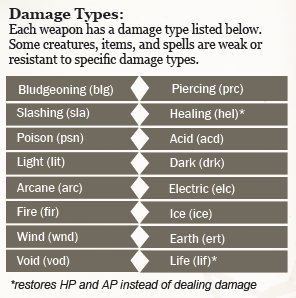
This just doesn’t belong. I’m struggling to think of an environment where these resistances and weaknesses are all going to show up. I’m sure it can be done, but you’d need to come up with a hell of a resource pool to have all your options on tap. On top of that, loot is supposed to come from a random roll chart, so it’s not like you’re intended to plan around what to procure.
We get a second mention of the resolution mechanic, but it’s still not the part that’s supposed to teach you how the system works. That’s a couple dozen pages off. It’s strange to me, but at least not entirely broke, that your attack roll is made with a number of dice set by your weapon, rather than your own stats. This should mitigate some of the random rolling issues, but then why differentiate between a beastly brawler and a total feeb of a wizard when they’re both going to be equally good at hitting someone with a sword? Again, not busted, just kind of inelegant.
You have access to arcane and mundane weapons. Why wouldn't we get a detailed list of weapons first and foremost? Arcane weapons use MP to do their thing, mundane ones don’t. In theory, your advancement schema comes from leveled unlocks and weapon forging. Say you want to be a wizard. You spend 60 of your 100 starting berries (did you remember how many nuts and grains each of those is?) to buy a spellbook. It comes with a specific basic attack that costs MP; some’ll have a secondary ability at level one as well, like a heal or a buff. On reaching a higher level, often second or third level, you’ll get a bigger, better version of that attack.
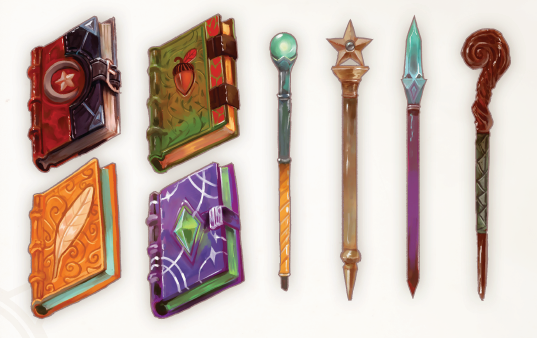
There are illustrated examples of each weapon in this chapter. They’re pretty charming! Very FF Tactics Advance.
Well, sometimes. Arcane items will always have a level-up skill, while mundane ones rarely do. Because wizard supremacy, I guess. The idea is that you also are picking up these mana stones along your journey - this is where that ridiculous resistance chart comes into play. Mana stones are gems from the action RPG of your choice - slot a gem into your weapon, get a new effect. Their effects can be a simple typed damage boost, to a whole set of level-gated powers that burn MP on use. Some are universal, some are limited to arcane or mundane weapons, some are typed to a specific type of weapon.
This is a great concept, if you’re going to focus on combat at least. It’s basically how weapons work in Monster Hunter. Instead of having the players fiddle with their own stats, they define their fighting style and abilities through their weapon, which they can alter to some degree. But! If you regem, you destroy the original mana stone you socketed in, and again, you’re mostly supposed to be getting these things through random rolling.
What is not a great concept is how armor works in Wild Lands. All armor is ablative. Wearing armor grants you Armor Points, which are treated like temporary HP. This isn’t a terrible notion in and of itself, but pile that on with the rest of the systems attached to armor. Armor can cap your evade dice, your primary and scarce resource of not getting hurt in the first place. Armor has stat requirements after a certain point. And armor is expensive.
Like, I’m against a la carte nickel-and-dime gear lists in general, but I understand pricing things so starting players can’t break the system accidentally. But here’s the thing - armor has a big THP pool. The max you can get are 130 extra HP from Mole Steel Plate; it requires Physicality 6, so at that stage you’re rolling with 36 “natural” HP, and that’s clearly a big deal. AP don’t refresh on their own, though. You have to pay to repair it, at half the armor’s cost each time. That Mole Plate costs 3.5 grains (currency conversion, remember?), and therefore 3.5 times the total starting gear resource available to a starting player each time you need to fix it. The money treadmill is a bad look, and yet again, your cash is coming from random drops.
The chapter closes out with some accessories and items. Accessories are pretty much transplanted from Final Fantasy, so you get two slots to increase a stat or obtain a magic attack, use a shield, and so on. No complaints here.
Items are mostly utility objects and HP/MP recovery items. A good deal of them are extremely Redwall, so there’s no less than three kinds of sweet condiments on the list. Rope, tent, bedroll, lanterns, you get the idea. There’s some weird discrepancies in here, though. You can buy a backpack, which lets you carry a set number of things. Prior to that entry, the only equipment limitations I can find are about how many items you can equip at a time. I’m still not sure if carrying capacity is broken out anywhere else. Likewise, there’s more rest-related things - a cup of tea gives you the equivalent of 8 hours of rest, but a bedroll gives you HP if you rest on it for six hours; just more stuff that needs an editing pass. A tent has limited uses, and prevents overnight encounters. While unfortunately there is a random encounter table, there’s no guidance on how to deploy it, how often you should roll on it, and so on. Shovels, fishing gear, thieves’ tools and generic toolkits all give “+2 to one roll when attempting to [DO THING].” It’s not apparent if that means they’re disposable, or they only benefit one type of roll, or whatever else you want to try and puzzle out. There’s an armor repair kit, which repairs 10 AP for every hour of use. Are you making checks each hour, or are you just allotting a time to work on fixing your stuff? Does the kit run out? Are you paying to repair your own armor versus taking it to a smith? Does it only repair mundane armor or magic sets too?
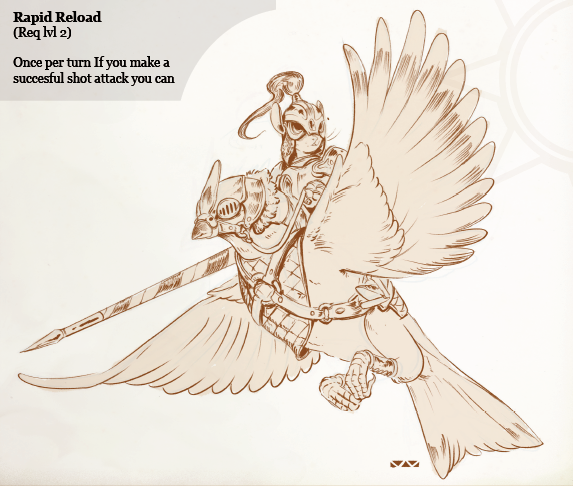
Not particularly relevant, but it’s a great illustration.
This chapter needs another few editing passes, and falls victim to the same D&D-ish narrative mechanic problem. Do we need all this stuff, and if we do, why does it touch on mechanical elements without actually giving you resolution effects? I know what salt is for, but how does a scroll of teleportation work? “Like in D&D” is the obvious answer, but you can spot the multiple problems with that statement.
Quite a few of these items are neat toys, and some even do a good job of capturing the imagination, but the implementation just isn’t there.
Or scold like a lawyer screaming wrong wrong wrong
Original SA post
Or scold like a lawyer screaming wrong wrong wrong
The Player’s Guide chapter is both short and I’ve covered most of it, since the rest of this writeup doesn’t make sense without knowing how to play the game.
The obligatory “What is a roleplaying game, what’s a GM, who am I” section is here. It takes up about a page, which is good, but there’s no reason it should be located this far back in the book.
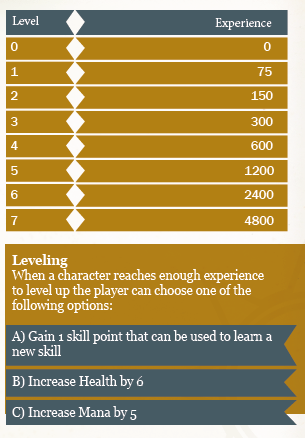
Absolutely not.
Here’s the entirety of what Wild Lands has to say about leveling up.
quote:
At the end of the quest experience points will be transferred to the players. It is important to note that players receive experience whether they succeed or fail. However, failure may result in the characters losing out on other opportunities
There’s no full stop at the end of that sentence, either.
We’ve got a concession to failing forward, but why is this broken out into XP levels? There’s no guide to how much XP is an appropriate award for completing a quest in the core book. You’ve got to go to the adventure guide for that, and that only covers level 1 and 2 quests. Want to guess how much experience you get from each?
A level 1 quest gives you 75 XP, and a level 2 grants 150. Enough to level on completion.
Well, that was pointless.
There’s a breakdown of what success count should be used to set difficulties for tests. Notation is given as “[Ability] AC (n),” e.g. “Phy AC(3)” means you’d need to roll a number of dice equal to your Physicality, plus bonus dice, and get three or more dice coming up five or six. No reason why this needed special notation, but okay.
Aiding another player is given a callout box. It’s an optional rule, and you can, once per day, aid another player character to give them +1 die on their checks. If your GM allows it, apparently. I’m going to be charitable and suppose this is to try and encourage players to act out on their own, rather than default to “I help Gus lift the gate/open the chest/scratch his ass.”
Failure is addressed, after a fashion, but it boils down to “sometimes your players won’t get the right number of successes. Tell them what happens and let them react.”
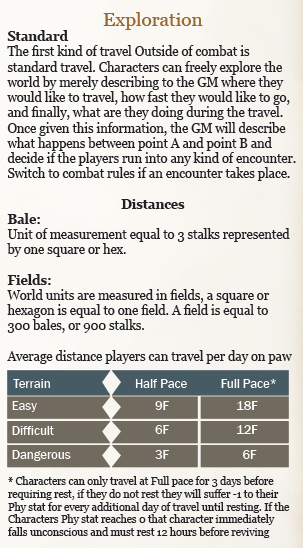
What even
Behold the sum total of exploration and encounter crafting rules outside of the random encounter table. Come on down, we’ve got special unit names, we’ve got internal contradictions, we got plenty of snakes and lizards for ‘em to play with, that ain’t no problem at all.
After a general description of the rules, combat comes up. Initiative is down to who gets the drop on the other side, or if it’s not clear, flip a coin. Straight up. Players move and act together, as do their opponents.
quote:
Players can take turns in whatever order works for the group, but going in a clockwise rotation around the table is traditional.
Is it?
As mentioned, a character’s turn is a standard and a quick action, plus movement. You can hold an action, but you have to write down what you want to do and what opposed action triggers your action. No.
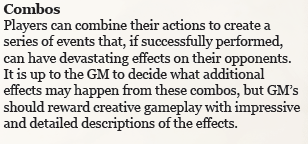
Fffffffff
Then there’s the best illustration in the game.
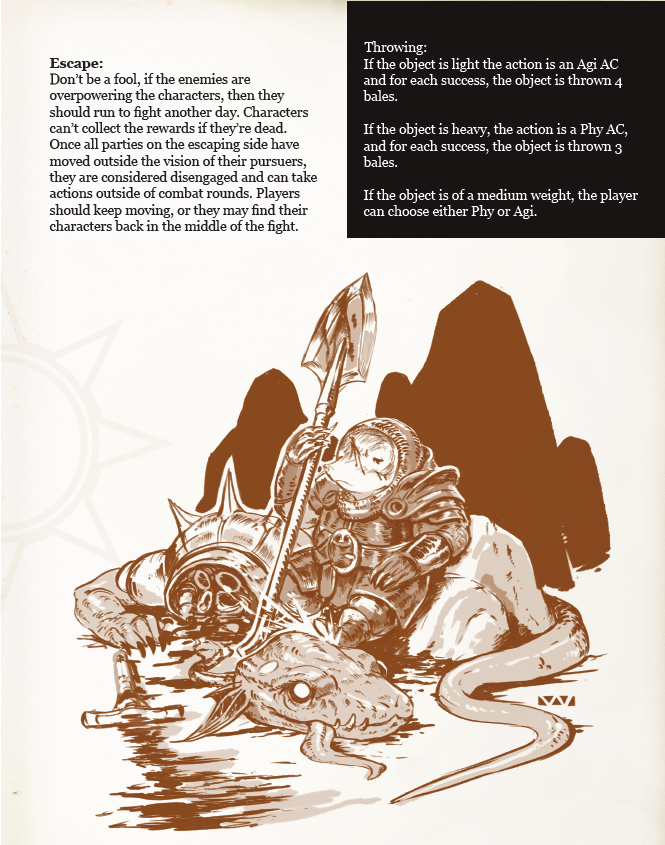
YEAAAAAHHHH
Shame about everything else on that page. How many granular levels of “I dunno” do you need in place of actual actionable rules, for god’s sake?
Beyond the gopher holes, there’s a world going on
Original SA post
Beyond the gopher holes, there’s a world going on
Wild Lands’ setting chapter starts out with cosmology.
Now, this is unfortunately a game where a working knowledge of planes is going to help you puzzle out how to interact with enemies. I get why this is here. I don’t care.
There aren’t stakes in this chapter, there aren’t any good adventure seeds. There’s nothing to get your teeth into. There are some good and evil gods, and there are some locations. Heroic NPCs are good but hard-working, evil monsters are cruel but malicious. Fine. I just described every mainstream fantasy roleplaying game’s setting.
I even understand why the setting is laying out its first principles. This is its “In the beginning, there was…” moment. I still don’t care. If I’m playing a Cold War game, I should probably know about the general geopolitical situation, and some recent history. Maybe you could stretch it out to the late 19th century with some understandings of that century’s revolutions and wars if you were running a politics-heavy scenario. I would not need to know about the detailed history of the Protestant Reformation or the Mongol invasions, even though they’re damn important events. I definitely wouldn’t expect to sit through a presentation on ancient history when I signed up for a rolicking adventure where I fight mustache-twirling KBG agents on top of a train.
Anyway, there’s the classical elemental planes for no damn reason, Heaven, Hell, and “The Strange,” which is the Lovecraft dimension. Octopi and Squids (enemies only, fools) are supposed to have come from the Strange.
Do you like fantasy proper nouns? Too bad, buddy, because there’s a bunch of gods you’re expected to know.
Oro the Golden - Good
Portfolio - Healing, Life, Light, Lightning
Golden stag. Oro’s followers roam the
Tal’ila Harbinger of Justice - Good
Portfolio - Justice, Law, Truth
A silver unicorn. Likes contracts and laws. Worshippers are guards, judges and detectives. Truthiness. There’s no comma in that name. Maybe “Tall-Ill-uh Harbingerofjustice” is a specific name.
Honorable Taur - Good
Portfolio - Honor, Nobility, Wisdom
“The followers of Taur seek honor above all else. Devotees gain honor by performing good acts and resisting any action that would be seen as evil or unjust. To lose honor would mean to lose status with Taur and rank within an order. Clerics of Taur are often warrior monks who defend against evil while paladins of Taur are Knights who strike out at evil.”
As in minotaur, see.
Orsa the Mystical - Neutral
Portfolio - Arcana, Knowledge, Air, Intrigue
A crystal bear that likes to know things. See, she views the world as a puzzle, and her followers want to solve this puzzle, if you will, and
Gharns Lord of Winter - Neutral
Portfolio - Death, Water, Ice, Winter
GHOST MOOSE Worshippers aren’t afraid of death, but they hate the undead. Now, stop me if you’ve heard this one before, but it’s said that Gharns visits the natural world during winter.
Terra Lady of Stone - Neutral
Portfolio - Earth, Stone, Gems, Battle
Obsidian wolverine. Dwarf god, but with no grudge-keeping.
Astria Lady of Summer - Neutral
Portfolio - Fire, Summer, War, Baking
Lion, but with a mane of fire. You know, baking being a domain of the god of fire is pretty good! Among the usual followers of this type of god, the text calls of “critters who love fire.” Probably the best god entry just for those two points alone.
Rasselbok the Twisted - Evil
Portfolio - Corruption, cruelty, poison
Jackalope Satan, supposed by the leading intellectuals of the world to be the cause of evil species, since anyone who worships Rasselbok inevitably mutates and becomes evil. No mechanics for mutation, and ol’ Scratch was banished to Hell by Oro, so I guess it doesn’t matter? Or they’re still able to reach out from Hell and screw with everyone else? This is all a little mushy throughout the rest of the game.
Trak’uul the Undying - Evil
Portfolio - Undead, hatred, darkness
Dracolich what causes zombies. There’s actually a story here! Back before critters were a thing, Trak’uul was a gigantic dragon. But when the death god showed up for his due, Tentacool here ran away to Hell, and is basically plotting ways to go back to the real world and live eternally. But also, basically Vecna. Definitely something to work with in this entry, though.
XyXrl - “Assumed Evil”
Portfolio - ????
It’s Cthulhu. Not even Hastur or Nyarlathotep. Cephalopods, do you understand?
The Great Isle
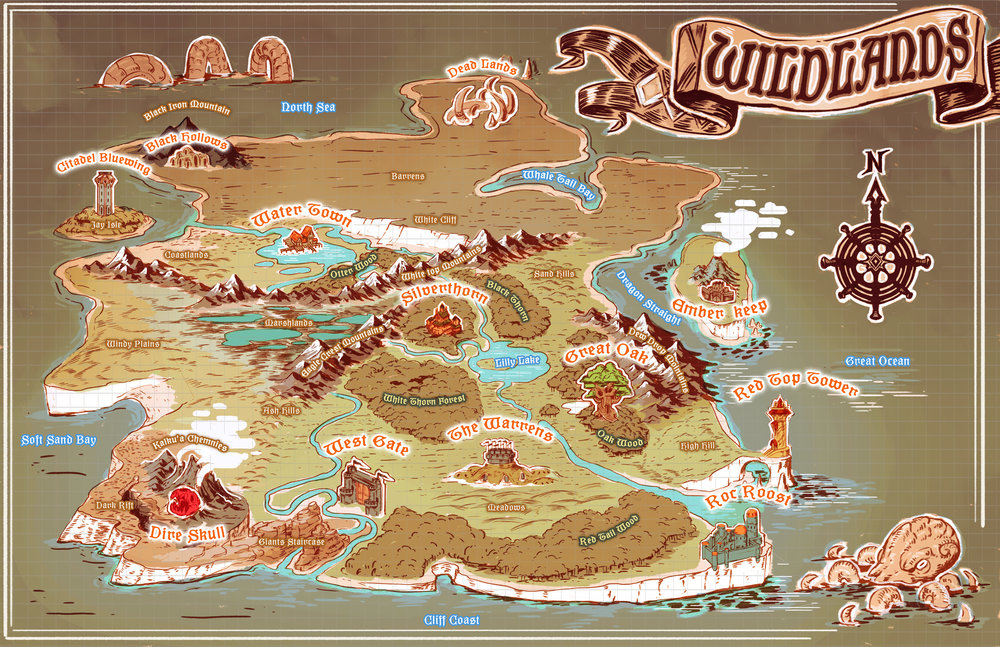
See that? That was five pages of Fantasy Environs where heroic heros hero heroically and dastardly dastards do dastardly deeds.
Organizations
When you hit level 3, you can prestige class instead of gaining a level. Would have been great to have this in the section about leveling. Your options are joining a religious order, a magical college, or a guild.
You’re not missing much, though. Take the Order of the Divine Light. You get the ability to feel uneasy in the presence of demons within 50 grid squares, and you can pop 15 MP to light a 10 (no unit used) diameter area, which makes Hell-monsters take -1 to rolls for three rounds. That is, technically speaking, more interesting than a skill point or HP/MP. Your organization options are not mechanically balanced against each other, of course. Which do you want more, +1 Evasion or +10 AP (no word on how it refreshes, though), or +1 die to brewing or identifying a potion?
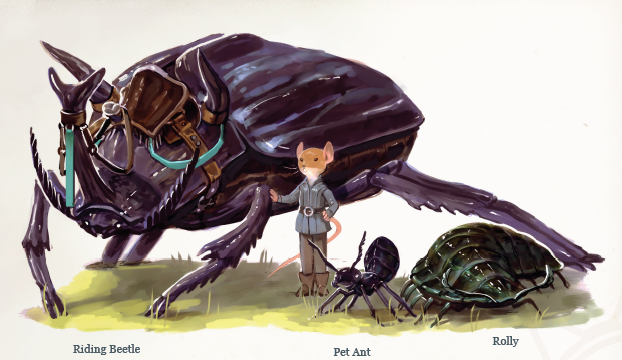
Yeah, pretty good.
Mounts are in this section. Ants, bees, chickens, geese, herons, sparrows. I would have liked to see some reptiles, but lizards of any stripe in the bestiary are sentient and evil, so I guess that’s out.
There’s a section on clothing, and that’s cool! Clothing is way more important than most games credit, and somebody’s sartorial choices are usually huge markers as to their personality, background, and all sorts of stuff. Leather in this world is from a particularly durable plant, which you can do all kinds of things to. It produces a sort of cotton bud too. Presumably the critters of Wild Lands aren’t big on wool for the same reason I wouldn’t wear a scarf made out of barbershop sweepings.
Food is touched on. Regionality is strong in the culinary arts, both for preference and determined by what’s available. We're not told what regions cook what. Berries, nuts and grains, but not those berries, nuts or grains, are common foodstuffs. Meat comes from bugs, crustaceans, fish and birds. Delicious food is known to have magical powers, which - gimme more of that. Give me more stuff that immediately makes me want to whip up Guy Ferretti, the wandering healer and gourmand, benefactor to countless mom and pop shops across the Great Isle.
Calendering is based off a calamitous event. Only two of the seasons are the same length, and “winter” is called “The Time of Gharns.” Bet you thought we were done with that crap. We’re told about Christmas and Halloween expys, which strongly feature a departing souls motif for both options. Again, I want to know more about that. Baking is considered a competitive sport. That’s just tossed off in a sidebar!
The little creatures of nature, they don’t know they’re ugly
Original SA post
The little creatures of nature, they don’t know they’re ugly
Wild Lands’ bestiary actually makes up a plurality of the book. At least it’s not spells!
Each entry that isn’t a generic critter has its own full-color illustration. Everything gets a little blurb about its behavior and habitats. Stat blocks go
quote:
Creature Name
Size category | Neutral/Evil Alignment | General creature type | Move in stalks
HP - AP
MP - Evade
Phy Agi Int Soc
Available attacks
Attack Dice - Damage - Damage Type
Range
Size is a general guide, but again has no particular effects. Fuck alignment. Do we benefit from knowing a giant fish is a type of fish? There’s no anti-fish weaponry in the game, to my knowledge. And again, a stalk is not a grid square in combat. Move of 120 st means you still have to divide by three, if you found that conversion while you were reading the rules.
Why are there separate HP and AP pools to track for NPCs? We don’t care if the orc has to skulk off and repair its armor. Why am I tracking an MP pool for a monster, when a cooldown is vastly easier to manage? Why do monsters get Evade dice, potentially cancelling out a player’s entire turn, instead of passively soaking damage?
(The answer to the AP pool is that there are piercing weapons, but answering "Why do I have so many things to track in this simple combat engine" with "here's another thing to track," ehhhhh)
Layout problems abound in this section. Here’s the specific page that made me stop and pause while I was reading the book the first time.
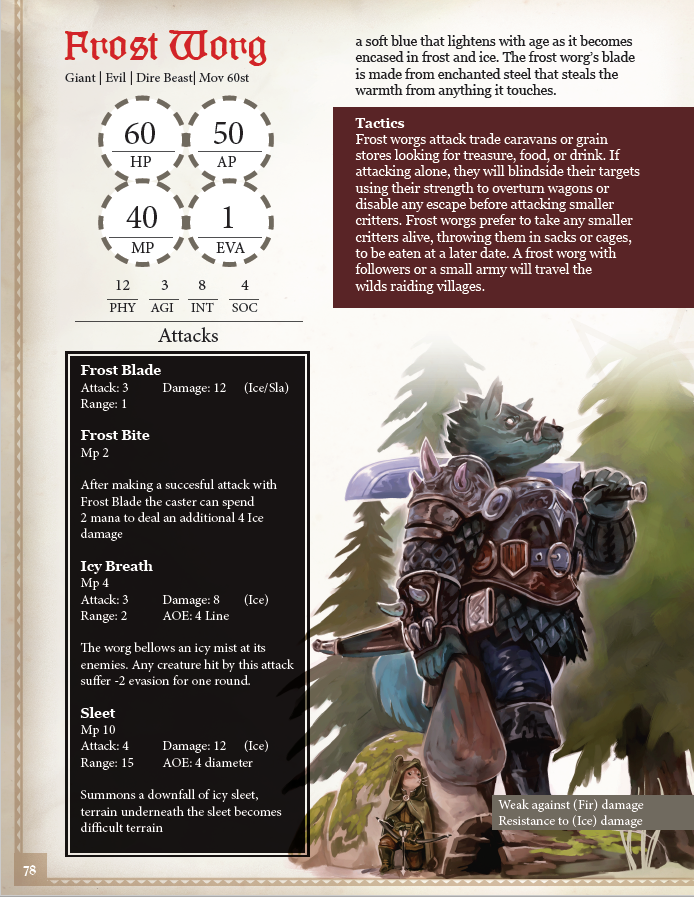
So, that says “Frost Worg” up at the top left. It’s not a great typeface. The descriptive text for this monster is split over the previous page. There’s no reason for that, especially considering each chapter is a header over a mostly blank page. But hey, a tactics callo-oh. It’s just describing background info, not an actual combat routine.
The attack bar is always coded black with white text, so it does stand out pretty nicely. You run into issues with cascading effects, like Frost Bite here, not being immediately obvious as dependent entries.
Here’s the thing, though. Did you see the little grey bar down in the bottom right of the page? Where it blends in with the illustration, since it’s middle grey? The thing that gives the monster’s weakness and resistance? Kind of important to hide, and damn if almost every entry here doesn’t do something similar.
As a minor mechanical quibble, monsters in this game are really mobile. 30 stalks - rather, 10 grid squares per round - is standard, which is faster than the average PC by one square per round. Meanwhile, this guy’s tearing around at twice that rate. The fastest a PC could be would be an AGI 6 mouse sprinting, and that’d get them up to 32 movement per round, if that’s all they did. I feel like you’re going to need some really complex combat maps, or some really huge spaces to make all this worthwhile.
The actual content of the Bestiary isn’t much to write home about. There are a lot of big animals, some of which are evil. It definitely starts out on a bad foot, because the entries here are categorized alphabetically, unlike in the freakin’ character creation chapter. That means our first introduction to the wild world of Wild Lands is fish - A is for Aquatic. They’re fish. There’s a big fish, and a little fish, and a littler fish for Moles to fight. They eat critters.
There is, however, the Aquatic Horror. It’s a pistol shrimp that also has an ink defense and constricting tentacles. Apparently they’re pretty tasty, and you can turn their plating into armor. Pretty good! There's a lot of hooks, no pun intended.
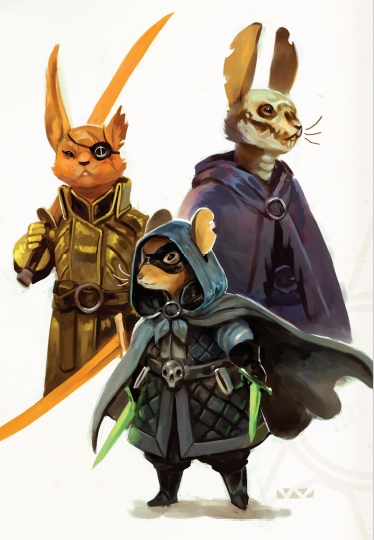
I don’t like the composition of this illustration, but I do like Nux the Bunny over there.
The specific Bandit entry comes before the category entry for Bad Critters, and that’s not good. You got bandits, mercenaries, and cultists. They’re all evil, of course. Highlights - you can try to buy out mercenaries to avoid a fight, though no pricing guidelines are given. Lowlights - cultists can summon a demon once per day. Again, weird mechanical intervals, and have fun paging back and forth between bestiary entries while you double your workload as a GM.
Dire Beasts are D&D elemental giants. Frost Warg, Thunder Lynx, an assortment of salamanders that vaguely follow a slaan lifecycle gimmick. The salamanders have death conditions and they’re all terrible. Any time one of them dies, they drop their flaming sword, which turns to dust. In the same box, we’re told if another salamander picks up the sword (and by definition they have their own, which is not a pile of dust) it springs back to life. This is left as an exercise to the reader. If you kill a little yellow salamander, the juveniles, they explode after three rounds. Okay, cool! That means you have to plan out your combat, or take special actions, and generally maneuver cleverly, I dig it. Green salamanders, their larger brothers, explode after an hour, and cause 10 damage over time. What’s this going to be used for except a gotcha against the players who take a rest on a battlefield, or someone who didn’t bury enemy corpses as a matter of course? Whoops, you guys didn’t respect the elemental monsters trying to kill you, now you’re responsible for a forest fire that killed dozens.
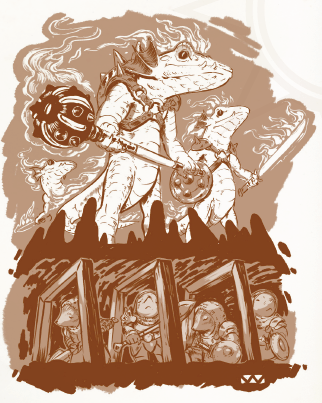
What do they call a mole in Scotland?
Demons are demons from
There are drakes. Not dragons, it says “drake” very clearly right there. It looks like a dragon, and one of them is even a giant devious schemer, but there are no dragons here. End of story.
There’s fey, and I’ll be honest, I think it’s kinda sus to describe them as “good or neutral,” but we’re dealing with the kind of idealized Fantasia fairies here, rather than the awful monsters from mythology. Fungi folk! Not too bad! Peaceful mushroom guys that come in day, night and woodland varieties. No great shakes mechanically, but they’re happy to tend their worm farms. You might get a quest to go kill some goblins from these guys.
And speaking of, Goblins are all warped descendants of former critters. This is distinct from someone who worshiped Rabbit Satan recently, which are underlings. They’re wandering monsters without much of a society, living as thieves and bandits, and occasionally as the hired muscle for more powerful beasts. Goblins are called out as not very intelligent, except for the single one in a generation who is [s]Jareth[/i] an excellent tactician and leader who can organize a horde. Goblins get a bonus to “raid in packs of 6 or greater.” Like, total six or more goblinoids on the board? Six adjacent? Does it persist if you kill one of the six, etc? Goblins will also mechanically attempt to flee once they’re outnumbered. No word on what happens if there’s nowhere to run at that point.
Goblin Goblins, or the prototypical version, are weird. They’re the disposable mook of this game. They’re stupid with maxed AGI, but they’re also slow to move around the board. They can also huck grenades? No word on what goblin goblins once were, but I’d assume mice.
Orcs are also goblins, the twisted remnants of boars, which are otherwise nowhere to be seen in this game. Orcs start to vary things up a big - you get a base stat block, with some alternate powers to simulate a warlock instead of your standard axe guy. Orcs deal an extra point of damage for every successful attack they land, up to +3. If they whiff, that resets to zero. Have fun tracking that.
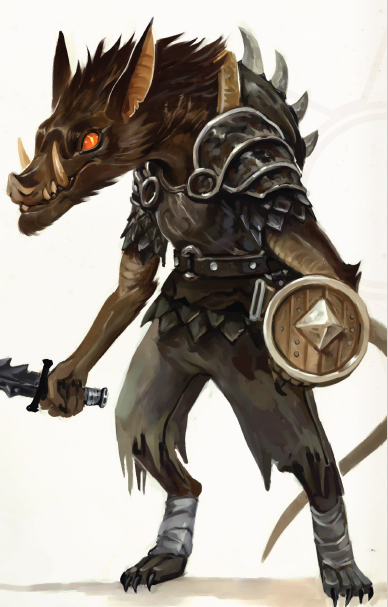
GNOll - Generic nonentity opponent, mk. II
Gnolls are a bit of a mess. Former rats that are supposed to be the sneaky assassin-y goblinoid. They have a follow-on to their main attack like a lot of aligned monsters, where they can spend MP to hit you with a point of poison damage if they damage you. But they also introduce facing into the combat system for a backstab entry. Surprise! We’re told gnolls come in packs of 8-12 like goblins, buuut we’ve also not actually been given any encounter-building framework at this point. It’s really all supposed to be keyed off that random encounter chart, but that also doesn’t tell you how many of the things you’re supposed to drop on the players.
There’s bugs and slimes. Have you played a fantasy game ever? Okay, moving on.
Strange creatures come from the Mythos plane. There’s lots of generic evocative names and mention of the dread god Too Many X’s. Suspects include Literally a Malboro but Upside Down, Bat with Too Many Wings, and that’s it. Welp.
Remember what I said about underlings in the goblin section? They’re the more recent addition to Rabbit Satan’s cult? Well, no they’re not, suddenly. Apparently nobody is worshiping Rabbit Satan actively, because they all turn into these things and they've been cursed for generations, but also there's a cultist entry for Rasselbok worshipers, so they are, and it's all very muddled. Underlings live underground and they don’t care for sunlight, but it doesn’t do anything to them mechanically. Kobolds are goblins, but weaker, and also uglier. Bugbears are orcs, but weaker, and cannibalistic.Trolls are more like a sahuagin, so a bigger, underwater orc, which is vaguely poisonous. They’re still weak to fire and regenerate, though.
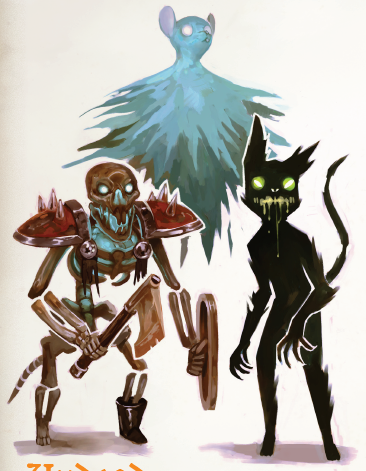
I don’t wanna be buried...
Undead are the usual suspects, but they take damage from healing spells, like in Final Fantasy. No particulars are given as to what would happen if you rubbed a skeleton with the healing strawberry jam, and that’s a shame. Great illustration, though.
The bestiary closes with a template to make your own monsters! It’s a blank character sheet with no guidance whatsoever.
Treasure’s a mixed bag, oh ho ho ho ho. For starters, not much in the way of illustrations here - everything's a generic treasure chest or an adventurer going on adventures, which isn't bad, but a definite contrast to the equipment chapter. Most of these entries should be in the gear chapter, because there’s a lot of “that thing you had, but more” effects involved. You’ve got a bag of holding equivalent, a magic lightbulb, a movement booster, items to increase your specific typed damage (by a whole two points, yeesh). Nothing here will capture your imagination if you’ve seen a DMG from any edition before.
Random treasure is generated by looking at a category, from small to “Dragon’s hoard” (no dragons!). You can get one, two, three, five, or eight rolls on the treasure table, depending on the size of the loot drop. No clarification as to how much treasure should be provided at a given moment, of course.
A full 40% of your treasure rolls will be on the underwhelming coin table, which is usually not much for your trouble, either. You’ve got a ten percent chance to pick up a mundane weapon, which may not be of a type you’re specced for. 5% chance for armor, which you may not be strong enough to use. 5% of your draws will be an FF accessory, which you may already have. Mundane items make up a full 20% of the loot table, so enjoy getting to the end of the campaign and stumbling over someone’s used camping gear and half-eaten bottle of jam. 8% of the time you’ll get a magic item, which cascades into a sub-table roll. Finally there’s a 2% chance you pick up a mana stone - you know, the thing you need to do anything with your character once you hit level 4 and up?
I also have no idea if these are total rolls for the whole party, or if you’re rolling a potential eight times on the tables for each character. It’d be good to have a recommended level of treasure by level, but that ain’t here.
Here’s an example of each kind of loot I just rolled.
Small - 40 Nuts, or 4 Berries, the actually useful coins
Medium - A maul and a glaive
Large - a piece of jerky (heal a whole 5 HP, once), chainmail, 8 Berries (the useful coin)
Trove - oil, nutcake, 9 Berries, a sweet roll, and a flail
Dragon’s Horde - 7 Berries, a sweet roll, 36 Nuts, basic spellbook, gloves that give you +2 Phy, 32 Berries, the same basic spellbook, oil
If you’re going to have rewards and progression gated behind random rolling, it needs to be something exciting and valuable at every level. Bounded probabilities are a thing! You should never have the best possible loot drop for your players resulting in pocket change worth less than their starting funds and items they could buy at chargen.
Wrapup
Original SA post
Wrapup
Wild Lands has a lot of problems. But this is a heartbreaker, not a horror show. They could be fixed.
I have no doubt that Stephen Wood sat down to work on Wild Lands with a very clear picture in his head of what he wanted it to be. I specifically mean “picture” - this is a game with strong and coherent aesthetic, and once you poke around the edges of that imagery you’re in rocky territory.
It’s one of the reasons I wanted to cover the system, because I fall into a lot of the same pitfalls when I come up with settings for my own games. My creative process for tabletop stuff is to come up with a couple gimmicks, draw out some things I think are cool and want to run a game around, and then work backwards to come up with a story and other setting details from there. If I need to come up with mechanics to support a particular play style, I’ll take bits and pieces from game systems I’ve used in the past and staple them together, even if they don’t entirely work.
So, y’know. Here we are.
More than anything, Wild Lands needs an editor. Part of it’s practical concerns - stuff needs to be organized more efficiently, certain layout decisions should be reconsidered, there needs to be consistency in certain mechanical effects, and so on. But it really needs some kill-your-darlings passes.
We’re given a lot that doesn’t amount to much. There’s a Redwall-ish setting, but none of the characters or even overwrought descriptions of food. There’s a Cthulhu dimension alongside the cute mushroom sprites. There’s elaborate combat options tied to a very basic rules framework. There’s random rolling for hugely mechanically important things, while at the same time you just sort of run out of things to do as a character the closer you get to higher levels of the game.
I could not describe this game to you beyond some basic mechanical terms and aesthetic details. “Kinda D&D but with animal people” is not as fleshed-out a phrase as you might think. Exalted is a godawful mess, and it’s absolutely a bigger mechanical car wreck than Wild Lands could ever be, but I can still pick out multiple (if contradictory) stories even the base book Exalted is trying to tell. Tenra Bansho Zero is a game about generic anime stereotypes being Extremely Anime at each other, but it still has a cohesive narrative backing it, and it immediately throws you plot hooks and all kinds of things to actually engage with in the setting. Hell, as a direct comparison to this game, there’s Mouse Guard, which explicitly gives you a pithy phrase to encapsulate what it’s about and what you’re going to do.
Give me a reason to pick this game up beyond the shiny packaging. I need a story to tell with this system, and there’s just nothing there. I couldn’t tell you what the author expects you to do with his game if there weren’t an adventure bundle out there. There’s no adventure hooks in the setting chapter or memorable NPCs beyond Rabbit Satan, and I only remember him because of the word count devoted to how ridiculous he is. I’m trying to stay away from the mechanical problems I have with the game, in no small part because of all the whining I’ve already done, but even there I can’t tell you if this is a game intended for kids or adults because of the systems choices it makes.
Also, stop using goofy made up terminology for things we otherwise inherently grasp. That part's non-negotiable. Here's a free one - it's called a foot because the unit of measurement was standardized by rabbits.
I still think Wild Lands is worth a purchase for the art, and because it’s a really high-production game that’s the work of just one person. That’s no mean feat in and of itself, and doubly so without a laborious crowdfunding process and all the horrors that entails.
I’d love to see a revised edition at some point, because I think this could be something special. Like, you want to give me a relatively rules-light system with cool Monster Hunter weapon swapping and upgrading? I get to go on adventures in a visually-arresting world, fight monsters twenty times my size, ride giant bugs and carouse with my friends? Hell yes, sign me up!
But this ultimately isn’t that game.
But it’s almost there.